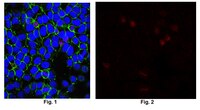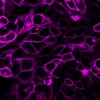Histochemistry evaluation of the oxidative stress and the antioxidant status in Cu-supplemented cattle.
García-Vaquero, M; Benedito, JL; López-Alonso, M; Miranda, M
Animal : an international journal of animal bioscience
6
1435-43
2012
显示摘要
The aim of this paper is to evaluate at a histopathological level the effect of the most commonly used copper (Cu) supplementation (15 mg/kg dry matter (DM)) in the liver of intensively reared beef cattle. This was done by a histochemistry evaluation of (i) the antioxidant capacity in the liver - by the determination of metallothioneins (MT) and superoxide dismutase (SOD) expression - as well as (ii) the possible induction of oxidative damage - by the determination of inducible nitric oxide synthase (iNOS), nitrotyrosine (NITT), malondialdehyde (MDA) and 8-oxoguanine (8-oxo) - that (iii) could increase apoptotic cell death - determined by cytochrome-c (cyto-c), caspase 1 (casp1) and terminal deoxynucleotidyl transferase dUTP nick end labeling (TUNEL). Liver samples from Cu-supplemented (15 mg Cu sulphate/kg DM, n = 5) and non-supplemented calves (n = 5) that form part of other experiments to evaluate Cu status were collected at slaughter and processed for immunohistochemistry and TUNEL. MT expression was diffuse and SOD showed slight changes although without statistical significance. iNOS and NITT positive (+) cells significantly increased, mainly around the central veins in the animals from the Cu-supplemented group, whereas no differences were appreciated for the rest of the oxidative stress and apoptosis markers. Under the conditions of this study, which are the conditions of the cattle raised in intensive systems in NW Spain and also many European countries, routinely Cu supplementation increased the risk of the animals to undergo subclinical Cu toxicity, with no significant changes in the Cu storage capacity and the antioxidant defensive system evaluated by MT and SOD expression, but with a significant and important increase of oxidative damage measured by iNOS and NITT. The results of this study indicated that iNOS and NITT could be used as early markers of initial pathological changes in the liver caused by Cu supplementation in cattle, although more studies in cattle under different levels of Cu supplementation are needed. | 23031516
 |
Induction of the intrinsic apoptosis pathway in insulin-secreting cells is dependent on oxidative damage of mitochondria but independent of caspase-12 activation.
Mehmeti, I; Gurgul-Convey, E; Lenzen, S; Lortz, S
Biochimica et biophysica acta
1813
1827-35
2011
显示摘要
Pro-inflammatory cytokine-mediated beta cell apoptosis is activated through multiple signaling pathways involving mitochondria and endoplasmic reticulum. Activation of organelle-specific caspases has been implicated in the progression and execution of cell death. This study was therefore performed to elucidate the effects of pro-inflammatory cytokines on a possible cross-talk between the compartment-specific caspases 9 and 12 and their differential contribution to beta cell apoptosis. Moreover, the occurrence of ROS-mediated mitochondrial damage in response to beta cell toxic cytokines has been quantified. ER-specific caspase-12 was strongly activated in response to pro-inflammatory cytokines; however, its inhibition did not abolish cytokine-induced mitochondrial caspase-9 activation and loss of cell viability. In addition, there was a significant induction of oxidative mitochondrial DNA damage and elevated cardiolipin peroxidation in insulin-producing RINm5F cells and rat islet cells. Overexpression of the H(2)O(2) detoxifying enzyme catalase effectively reduced the observed cytokine-induced oxidative damage of mitochondrial structures. Taken together, the results strongly indicate that mitochondrial caspase-9 is not a downstream substrate of ER-specific caspase-12 and that pro-inflammatory cytokines cause apoptotic beta cell death through activation of caspase-9 primarily by hydroxyl radical-mediated mitochondrial damage. | 21784110
 |
Mitochondrial DNA toxicity compromises mitochondrial dynamics and induces hippocampal antioxidant defenses.
Lauritzen, KH; Cheng, C; Wiksen, H; Bergersen, LH; Klungland, A
DNA repair
10
639-53
2011
显示摘要
Mitochondria are highly dynamic organelles that can be actively transported within the cell to satisfy local requirements. They are vital for providing cellular energy, but are also an important endogenous source of reactive oxygen species. The distribution of mitochondria is particularly important for neurons because of the morphological complexity of these cells, and because neural processing is metabolically expensive. Defects in mitochondrial distribution, observed in several neurodegenerative diseases, can result in synaptic dysfunction. We have generated transgenic mice expressing an enzyme in forebrain neurons that causes mitochondrial DNA (mtDNA) damage in the form of abasic-sites, creating mtDNA toxicity. Here, we report that mitochondrial distribution is disturbed in hippocampal neurons of these mice. Moreover, mtDNA copy number and mitochondrial transcription are reduced, and oxidative stress is increased. There is also a loss of receptors at excitatory glutamatergic synapses in the dentate gyrus, and the size of the postsynaptic density in this region is abnormal. We speculate that the loss of synaptic mitochondria caused by accumulation in the neuronal cell body contributes to the observed synaptic abnormalities, as well as the overall loss of mtDNA and diminished mitochondrial transcription. Collectively, these changes lead to mitochondria with reduced function and increased oxidative stress. | 21550321
 |
Trypanosoma cruzi induces the reactive oxygen species-PARP-1-RelA pathway for up-regulation of cytokine expression in cardiomyocytes.
Ba, X; Gupta, S; Davidson, M; Garg, NJ
The Journal of biological chemistry
285
11596-606
2010
显示摘要
In this study, we demonstrate that human cardiomyocytes (AC16) produce reactive oxygen species (ROS) and inflammatory cytokines in response to Trypanosoma cruzi. ROS were primarily produced by mitochondria, some of which diffused to cytosol of infected cardiomyocytes. These ROS resulted in an increase in 8-hydroxyguanine lesions and DNA fragmentation that signaled PARP-1 activation evidenced by poly(ADP-ribose) (PAR) modification of PARP-1 and other proteins in infected cardiomyocytes. Phenyl-alpha-tert-butylnitrone blocked the mitochondrial ROS (mtROS) formation, DNA damage, and PARP-1 activation in infected cardiomyocytes. Further inhibition studies demonstrated that ROS and PARP-1 signaled TNF-alpha and IL-1beta expression in infected cardiomyocytes. ROS directly signaled the nuclear translocation of RelA (p65), NF-kappaB activation, and cytokine gene expression. PARP-1 exhibited no direct interaction with p65 and did not signal its translocation to nuclei in infected cardiomyocytes. Instead, PARP-1 contributed to PAR modification of p65-interacting nuclear proteins and assembly of the NF-kappaB transcription complex. PJ34 (PARP-1 inhibitor) also prevented mitochondrial poly(ADP-ribosyl)ation (PARylation) and ROS formation. We conclude that T. cruzi-mediated mtROS provide primary stimulus for PARP-1-NF-kappaB activation and cytokine gene expression in infected cardiomyocytes. PAR modification of mitochondrial membranes then results in a feedback cycle of mtROS formation and DNA damage/PARP-1 activation. ROS, either through direct modulation of cytosolic NF-kappaB, or via PARP-1-dependent PAR modification of p65-interacting nuclear proteins, contributes to cytokine gene expression. Our results demonstrate a link between ROS and inflammatory responses in cardiomyocytes infected by T. cruzi and provide a clue to the pathomechanism of sustained inflammation in Chagas disease. 全文本文章 | 20145242
 |
Adding insult to injury: effects of xenobiotic-induced preantral ovotoxicity on ovarian development and oocyte fusibility.
Sobinoff, AP; Pye, V; Nixon, B; Roman, SD; McLaughlin, EA
Toxicological sciences : an official journal of the Society of Toxicology
118
653-66
2010
显示摘要
Mammalian females are born with a finite number of nonrenewing primordial follicles, the majority of which remain in a quiescent state for many years. Because of their nonrenewing nature, these "resting" oocytes are particularly vulnerable to xenobiotic insult, resulting in premature ovarian senescence and the formation of dysfunctional oocytes. In this study, we characterized the mechanisms of ovotoxicity for three ovotoxic agents, 4-vinylcyclohexene diepoxide (VCD), methoxychlor (MXC), and menadione (MEN), all of which target immature follicles. Microarray analysis of neonatal mouse ovaries exposed to these xenobiotics in vitro revealed a more than twofold significant difference in transcript expression (p less than 0.05) for a number of genes associated with apoptotic cell death and primordial follicle activation. Histomorphological and immunohistological analysis supported the microarray data, showing signs of primordial follicle activation and preantral follicle atresia both in vitro and in vivo. Sperm-oocyte fusion assays on oocytes obtained from adult Swiss mice treated neonatally revealed severely reduced sperm-egg binding and fusion in a dose-dependent manner for all the xenobiotic treatments. Additionally, lipid peroxidation analysis on xenobiotic-cultured oocytes indicated a dose-dependent increase in oocyte lipid peroxidation for all three xenobiotics in vitro. Our results reveal a novel mechanism of preantral ovotoxicity involving the homeostatic recruitment of primordial follicles to maintain the pool of developing follicles destroyed by xenobiotic exposure and to our knowledge provide the first documented evidence of short-term, low- and high-dose (VCD 40-80 mg/kg/day, MXC 50-100 mg/kg/day, MEN 7.5-15 mg/kg/day) neonatal exposure to xenobiotics causing long-term reactive oxygen species-induced oocyte dysfunction. | 20829426
 |
Immunofluorescent localization of the murine 8-oxoguanine DNA glycosylase (mOGG1) in cells growing under normal and nutrient deprivation conditions.
Conlon, KA; Zharkov, DO; Berrios, M
DNA repair
2
1337-52
2003
显示摘要
OGG1 is a major DNA glycosylase in mammalian cells, participating in the repair of 7,8-dihydro-8-oxoguanine (8-oxoguanine, 8-oxoG), the most abundant known DNA lesion induced by endogenous reactive oxygen species in aerobic organisms. 8-oxoG is therefore often used as a marker for oxidative DNA damage. In this study, polyclonal and monoclonal antibodies were raised against the purified wild-type recombinant murine 8-oxoG DNA glycosylase (mOGG1) protein and their specificity against the native enzyme and the SDS-denatured mOGG1 polypeptide were characterized. Specific antibodies directed against the purified wild-type recombinant mOGG1 were used to localize in situ this DNA repair enzyme in established cell lines (HeLa cells, NIH3T3 fibroblasts) as well as in primary culture mouse embryo fibroblasts growing under either normal or oxidative stress conditions. Results from these studies showed that mOGG1 is localized to the nucleus and the cytoplasm of mammalian cells in culture. However, mOGG1 levels increase and primarily redistribute to the nucleus and its peripheral cytoplasm in cells exposed to oxidative stress conditions. Immunofluorescent localization results reported in this study suggest that susceptibility to oxidative DNA damage varies among mammalian tissue culture cells and that mOGG1 appears to redistribute once mOGG1 cell copy number increases in response to oxidative DNA damage. | 14642563
 |



















